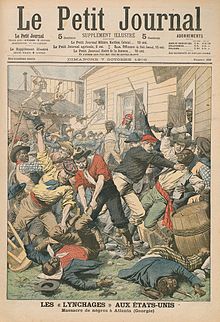In the broader context of racism against Black Americans and racism in the United States, mass racial violence in the United States consists of ethnic conflicts and race riots, along with such events as:

The Tulsa race massacre, also known as the Tulsa race riot or the Black Wall Street massacre, was a two-day-long white supremacist terrorist massacre that took place between May 31 and June 1, 1921, when mobs of white residents, some of whom had been appointed as deputies and armed by city government officials, attacked black residents and destroyed homes and businesses of the Greenwood District in Tulsa, Oklahoma. The event is considered one of the worst incidents of racial violence in American history. The attackers burned and destroyed more than 35 square blocks of the neighborhood—at the time one of the wealthiest black communities in the United States, colloquially known as "Black Wall Street".
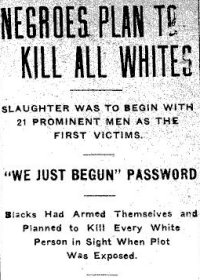
The Elaine massacre occurred on September 30–October 2, 1919 at Hoop Spur in the vicinity of Elaine in rural Phillips County, Arkansas. As many as several hundred African Americans and five white men were killed. Estimates of deaths made in the immediate aftermath of the Elaine Massacre by eyewitnesses range from 50 to "more than a hundred". Walter Francis White, an NAACP attorney who visited Elaine shortly after the incident, stated "... twenty-five Negroes killed, although some place the Negro fatalities as high as one hundred". More recent estimates in the 21st century of the number of black people killed during this violence are higher than estimates provided by the eyewitnesses, and have ranged into the hundreds. Robert Whitaker estimated 856 people were killed in his 2008 book on this topic. The white mobs were aided by federal troops and local terrorist organizations. Gov. Brough led a contingent of 583 US soldiers from Camp Pike, with a 12-gun machine gun battalion.

The Rosewood massacre was a racially motivated massacre of black people and the destruction of a black town that took place during the first week of January 1923 in rural Levy County, Florida, United States. At least six black people were killed, but eyewitness accounts suggested a higher death toll of 27 to 150. In addition, two white people were killed in self-defense by one of the victims. The town of Rosewood was destroyed in what contemporary news reports characterized as a race riot. Florida had an especially high number of lynchings of black men in the years before the massacre, including the lynching of Charles Strong and the Perry massacre in 1922.

Red Summer was a period in mid-1919 during which white supremacist terrorism and racial riots occurred in more than three dozen cities across the United States, and in one rural county in Arkansas. The term "Red Summer" was coined by civil rights activist and author James Weldon Johnson, who had been employed as a field secretary by the National Association for the Advancement of Colored People (NAACP) since 1916. In 1919, he organized peaceful protests against the racial violence.
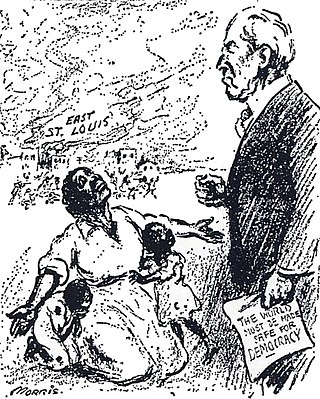
The East St. Louis massacre was a series of violent attacks on African Americans by white Americans in East St. Louis, Illinois between late May and early July of 1917. These attacks also displaced 6,000 African Americans and led to the destruction of approximately $400,000 worth of property. They occurred in East St. Louis, an industrial city on the east bank of the Mississippi River, directly opposite the city of St. Louis, Missouri. The July 1917 episode in particular was marked by white-led violence throughout the city. The multi-day rioting has been described as the "worst case of labor-related violence in 20th-century American history", and among the worst racial riots in U.S. history.
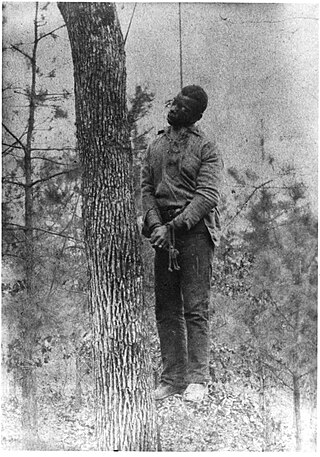
Lynching was the widespread occurrence of extrajudicial killings which began in the United States' pre–Civil War South in the 1830s and ended during the civil rights movement in the 1950s and 1960s. Although the victims of lynchings were members of various ethnicities, after roughly 4 million enslaved African Americans were emancipated, they became the primary targets of white Southerners. Lynchings in the U.S. reached their height from the 1890s to the 1920s, and they primarily victimised ethnic minorities. In 1891, the largest single mass lynching in American history was perpetrated in New Orleans against Italian immigrants. Most of the lynchings occurred in the American South, as the majority of African Americans lived there, but racially motivated lynchings also occurred in the Midwest and border states.

The Wilmington insurrection of 1898, also known as the Wilmington massacre of 1898 or the Wilmington coup of 1898, was a coup d'état and a massacre which was carried out by white supremacists in Wilmington, North Carolina, United States, on Thursday, November 10, 1898. The white press in Wilmington originally described the event as a race riot caused by black people. Since the late 20th century and further study, the event has been characterized as a violent overthrow of a duly elected government by a group of white supremacists.
The Commission on Interracial Cooperation (1918–1944) was an organization founded in Atlanta, Georgia, December 18, 1918, and officially incorporated in 1929. Will W. Alexander, pastor of a local white Methodist church, was head of the organization. It was formed in the aftermath of violent race riots that occurred in 1917 in several southern cities. In 1944 it merged with the Southern Regional Council.
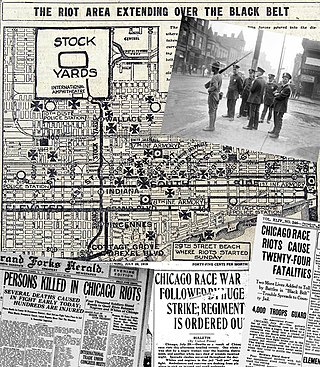
The Chicago race riot of 1919 was a violent racial conflict between white Americans and Black Americans that began on the South Side of Chicago, Illinois, on July 27 and ended on August 3, 1919. During the riot, 38 people died. Over the week, injuries attributed to the episodic confrontations stood at 537, two thirds Black and one third white; and between 1,000 and 2,000 residents, most of them Black, lost their homes. Due to its sustained violence and widespread economic impact, it is considered the worst of the scores of riots and civil disturbances across the United States during the "Red Summer" of 1919, so named because of its racial and labor violence. It was also one of the worst riots in the history of Illinois.

The Robert Charles riots of July 24–27, 1900 in New Orleans, Louisiana were sparked after Afro-American laborer Robert Charles fatally shot a white police officer during an altercation and escaped arrest. A large manhunt for him ensued, and a white mob started rioting, attacking blacks throughout the city. The manhunt for Charles began on Monday, July 23, 1900, and ended when Charles was killed on Friday, July 27, shot by a special police volunteer. The mob shot him hundreds more times, and beat the body.

Jim McMillan was lynched in Bibb County, Alabama on June 18, 1919.

In Forsyth County, Georgia, in September 1912, two separate alleged attacks on white women in the Cumming area resulted in black men being accused as suspects. First, a white woman reportedly awoke to find a black man in her bedroom; then days later, a teenage white woman was beaten and raped, later dying of her injuries.
The Ocoee massacre was a mass racial violence event that saw a white mob attack numerous African-American residents in the northern parts of Ocoee, Florida, a town located in Orange County near Orlando. Previously inhabited by the Seminoles, Ocoee was the home to 255 African-American residents and 560 white residents according to the 1920 Census. The massacre took place on November 2, 1920, the day of the U.S. presidential election leaving a lasting political, but also community impact, as the 1930 census shows 1,180 whites, 11 Native Americans, and 2 African Americans (0.2%).

The Washington race riot of 1919 was civil unrest in Washington, D.C. from July 19, 1919, to July 24, 1919. Starting July 19, white men, many in the armed forces, responded to the rumored arrest of a black man for rape of a white woman with four days of mob violence against black individuals and businesses. They rioted, randomly beat black people on the street, and pulled others off streetcars for attacks. When police refused to intervene, the black population fought back. The city closed saloons and theaters to discourage assemblies. Meanwhile, the four white-owned local papers, including the Washington Post, fanned the violence with incendiary headlines and calling in at least one instance for mobilization of a "clean-up" operation. After four days of police inaction, President Woodrow Wilson ordered 2,000 federal troops to regain control in the nation's capital. But a violent summer rainstorm had more of a dampening effect. When the violence ended, 15 people had died: at least 10 white people, including two police officers; and around 5 black people. Fifty people were seriously wounded and another 100 less severely wounded. It was one of the few times in 20th-century riots of whites against blacks that white fatalities outnumbered those of black people. The unrest was also one of the Red Summer riots in America.

Berry Washington was a 72-year-old black man who was lynched in Milan, Georgia, in 1919. He was in jail after killing a white man who was attacking two young girls. He was taken from jail and lynched by a mob.

The Johnson–Jeffries riots refer to the dozens of race riots that occurred throughout the United States after African-American boxer Jack Johnson defeated white boxer James J. Jeffries in a boxing match termed the "Fight of the Century". Johnson became the first black World Heavyweight champion in 1908 which made him unpopular with the predominantly white audience of boxing. Jeffries, a former heavyweight champion came out of retirement to fight Johnson and was nicknamed the "Great White Hope". After Johnson defeated Jeffries on July 4, 1910, many white people felt humiliated and began attacking black people who were celebrating Johnson's victory.
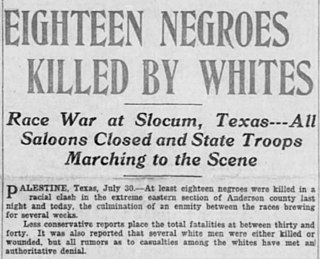
The Slocum Massacre occurred on July 29–30, 1910, in Slocum, Texas, an unincorporated community in Anderson County near Palestine in East Texas. Only six deaths were officially confirmed, but some 22 were reported by major newspapers. This is the official count, and it is estimated as many as one hundred African Americans were killed.

Miles Phifer and Robert Crosky were lynched in Montgomery, Alabama for allegedly assaulting a white woman.
